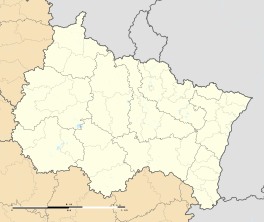Stiring-Wendel
| Stiring-Wendel | ||
|---|---|---|
|
Église Saint-François | ||
| ||
 Stiring-Wendel | ||
|
Location within Grand Est region  Stiring-Wendel | ||
| Coordinates: 49°12′N 6°56′E / 49.20°N 6.93°ECoordinates: 49°12′N 6°56′E / 49.20°N 6.93°E | ||
| Country | France | |
| Region | Grand Est | |
| Department | Moselle | |
| Arrondissement | Forbach-Boulay-Moselle | |
| Canton | Stiring-Wendel | |
| Intercommunality | Forbach Porte de France | |
| Government | ||
| • Mayor (2014–2020) | Jean-Claude Holtz | |
| Area1 | 3.6 km2 (1.4 sq mi) | |
| Population (2006)2 | 12,588 | |
| • Density | 3,500/km2 (9,100/sq mi) | |
| Time zone | CET (UTC+1) | |
| • Summer (DST) | CEST (UTC+2) | |
| INSEE/Postal code | 57660 / 57350 | |
| Elevation |
205–254 m (673–833 ft) (avg. 240 m or 790 ft) | |
|
1 French Land Register data, which excludes lakes, ponds, glaciers > 1 km² (0.386 sq mi or 247 acres) and river estuaries. 2 Population without double counting: residents of multiple communes (e.g., students and military personnel) only counted once. | ||
Stiring-Wendel (Lorraine Franconian: Stiringe, German Stieringen-Wendel) is a commune in the Moselle department in Grand Est in north-eastern France, wedged between Forbach, Schœneck, Spicheren and Saarbrücken.
History
Founded in 1846 at the site of the present Stiring-Wendel ironworks. The industrial family Wendel built a church, a school and residential facilities for the workers.
By imperial decree of Napoleon III, the city is elevated to a fully autonomous municipality June 3, 1857, and separate from Forbach.
After the Franco-Prussian War of 1870, the city as part of Alsace-Lorraine came under German control. The steel industry collapsed with its final closure in 1897.
In 1897 the rise of the coal industry generated a new economy, and led to an increase in population. For example, in 1857 the population was 1900, where by 1957 it had grown to 16,000 residents.
After World War I, in 1918, Alsace-Lorraine returned to French control.
The Forbach and Stiring-Wendel area were heavy battlefields during World War II. Stiring-Wendel held many German POW camps to run the mines, which were liberated after the battles. Most of the armored American forces in this area turned north at this point to counter the German advance into Belgium ("Battle of the Bulge").
France began administering the German Saar region as a protectorate after World War II. The Marshall Plan returned the Saar to German control in 1957, due to both economic and political demands. The borders of Germany and France were then aligned to the positions before 1870, drawing the border line right next to Stiring-Wendel.
The people of Forbach and Stiring-Wendel are generally bi-lingual (French-German).
Notable people from Stiring-Wendel
- Sophie Huber, Beijing 2008 Olympics swimmer (Born in Forbach)
- Patricia Kaas, Singer (Born in Forbach)
- Nicolas Untersteller, Famous Painter and member of Académie des Beaux-Arts
- Charles de Wendel, Industrialist, Founder
See also
External links
| Wikimedia Commons has media related to Stiring-Wendel. |

